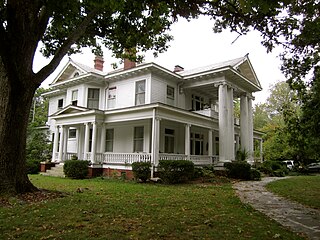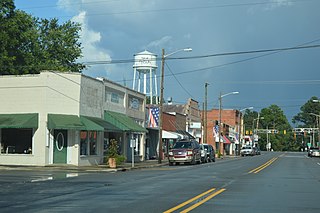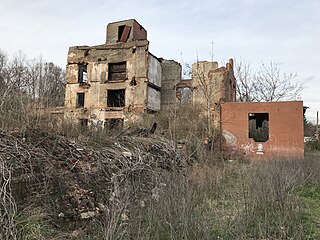
Oakwood Historic District is a national historic district located at Hickory, Catawba County, North Carolina. It includes work designed by architects Wheeler & Stearn. It encompasses 50 contributing buildings, 1 contributing site, and 1 contributing structure in an upscale residential section of Hickory. It includes notable examples of Colonial Revival, Bungalow / American Craftsman, and Queen Anne style architecture dating from the 1880s to 1930s. Notable buildings include the Robert E. Simpson House (1922), Walker Lyerly House (1913), Cline-Wilfong House (1912), Abel A. Shuford, II House, Paul A. Setzer House (1927), John H. P. Cilley House (1912), (first) Charles H. Geitner House (1900), Benjamin F. Seagle House, David L. Russell House, Robert W. Stevenson House, Jones W. Shuford House (1907), Dr. Robert T. Hambrick House (1928), Alfred P. Whitener House, and J. Summie Propst House (1881-1883).

The Monroe Residential Historic District is a national historic district located at Monroe, Union County, North Carolina. It encompasses 376 contributing buildings, 1 contributing site, and 4 contributing objects in a predominantly residential section of Monroe. The district developed between about 1874 and 1940 and includes notable examples of Italianate, Queen Anne, and Classical Revival architecture styles and includes work by architects Wheeler & Stern and by G. Marion Tucker. Notable buildings include the R. V. Houston House, Houston-Redfearn House, the Belk House, J. H. Lee House, M. G. Sheppard House, Elizabeth Friedeman House, former Methodist Parsonage, Gaston Meares House, William E. Cason House, M. G. Sheppard House, and George B. McClellan House.

Claremont High School Historic District is a national historic district located at Hickory, Catawba County, North Carolina. The district encompasses 172 contributing buildings and 3 contributing structures in a predominantly residential section of Hickory. Most of the dwellings date from the late 19th through mid-20th century and include notable examples of Queen Anne, Colonial Revival, Tudor Revival, and Bungalow / American Craftsman style architecture. The Claremont High School was completed in 1925, and is a three-story, "H"-shaped, Neoclassical style school. The school was rehabilitated in 1986 as an arts and science center. Other notable buildings include Maple Grove, Shuler-Harper House (1887), Harvey E. McComb House (1889), (former) Corinth Reformed Church Parsonage (1895), Shuford L. Whitener House, Judge W. B. Councill House (1902), George W. Hall House, Carolina Park, Josephine Lyerly House, John L. Riddle House (1918), Marshall R. Wagner House (1938), David M. McComb Jr., House (1939), Arthur H. Burgess House (1940), and R. L. Noblin House (1950).

Hope Mills Historic District is a national historic district located at Hope Mills, Cumberland County, North Carolina. It encompasses 61 contributing buildings and 3 contributing sites in the central business district of Hope Mills. Ii includes industrial, commercial, religious, and residential buildings and includes notable examples of Federal and Late Victorian style architecture. Notable buildings include the (former) Hope Mills Manufacturing Company buildings, Rockfish Manufacturing Company, Colin MacRae House, Christ Episcopal Church, Lebanon Masonic Lodge No. 391, and Alice L. Gilbert Store.

Faison Historic District is a national historic district located at Faison, Duplin County, North Carolina. The district encompasses 116 contributing buildings, 2 contributing structures, and 1 contributing object in the central business district and surrounding residential area of Faison. It includes industrial, residential, and commercial buildings with notable examples of Greek Revival, Queen Anne, and Italianate style architecture. Notable buildings include the Cates Pickle Company (1931), Moore Lee Thornton Store, C. S. Hines Store, Clifton's Service Station (1933), The Walter Livingston Hicks House, Faison Pharmacy, Witherington Building (1915), Faison Depot (1888), Presbyterian Church (1918), Elias Faison House, Faison-Williams House (1853), and Witherington House (1880).

Trinity Historic District, also called Trinity Park, is a national historic district and residential area located near the East Campus of Duke University in Durham, North Carolina. The district encompasses 751 contributing buildings in a predominantly residential section of Durham. They were built between the 1890s and 1960 and include notable examples of Queen Anne and Bungalow / American Craftsman style architecture. Located in the district are the separately listed "Faculty Row" cottage: the Bassett House, Cranford-Wannamaker House, Crowell House, and Pegram House. Other notable buildings include the George W. Watts School (1917), Julian S. Carr Junior High School (1922), Durham High School (1923), Durham Alliance Church (1927), Trinity Presbyterian Church (1925), Great A & P Tea Company (1927-1929), Grace Lutheran Church, and the former Greek Orthodox Community Church.

Belmont Historic District is a national historic district located at Belmont, Gaston County, North Carolina. It encompasses 264 contributing buildings, 1 contributing site, and 2 contributing structures in the central business district and adjacent residential areas of Belmont. The district was developed after 1873, and includes notable examples of Colonial Revival, Tudor Revival, and Bungalow / American Craftsman architecture. Located in the district is the separately listed U.S. Post Office, Former. Other notable buildings include the R.L. Stowe Mills Office Building, Bank of Belmont (1926), Piedmont and Northern Railroad Depot, Belmont Hotel, Abel C. Lineberger House No. 2 designed by Charles Christian Hook (1870–1938), Samuel Pinckney Stowe House, James W. Stowe House, Sacred Heart College, and Belmont High School (1939).

Fisher Park Historic District is a national historic district in the Fisher Park neighborhood, Greensboro, Guilford County, North Carolina. The district encompasses 541 contributing buildings, 2 contributing sites, and 44 contributing structures in a predominantly residential section of Greensboro. The houses were largely built between the 1900s and 1930s and include notable examples of Queen Anne, Colonial Revival, Gothic Revival, American Foursquare, and Bungalow / American Craftsman-style architecture. Located in the district are the separately listed Dixon-Leftwich-Murphy House, John Marion Galloway House, Julian Price House, and Latham-Baker House. Other notable buildings include the First Presbyterian Church (1928), Holy Trinity Episcopal Church (1922), Gant-McAlister House, and A.J. Schlosser House.

Weldon Historic District is a national historic district located at Weldon, Halifax County, North Carolina. It encompasses 256 contributing buildings, 2 contributing structures, and 9 contributing structures in the central business district and surrounding residential sections of the town of Weldon. The district includes notable examples of Queen Anne, Colonial Revival, and Bungalow / American Craftsman style architecture. The district overlaps the Roanoke Canal Historic District. Notable buildings include the Larkin-Hart House, Ashley L. Stainback House c. (1879), Smith-Dickens House (1901-1902), DeLeon F. Green House (1934) designed by William Lawrence Bottomley, Emry-Zollicoffer Building (1877), Bank of Weldon Building, George C. Green Building/Bank of Halifax Building (1915), Weldon Grocery Company Building (1913), (former) Weldon Town Hall (1893), United States Post Office (1938), Weldon Freight Depot, Coca-Cola Bottling Company (1925), and Atlantic Coast Line Railroad Embankment and Viaduct.

East Broad Street–Davie Avenue Historic District is a national historic district located at Statesville, Iredell County, North Carolina. It encompasses 65 contributing buildings in a predominantly residential section of Statesville. The district includes notable examples of Late Victorian architecture and were mainly built between about 1880 and 1930. Notable buildings include the Elma Apartments building, Matt-Simons House, J. S. Ramsey House, and Major H. L. Allison House.

South Race Street Historic District is a national historic district located at Statesville, Iredell County, North Carolina. It encompasses 85 contributing buildings in a planned mixed residential and commercial section of Statesville. The district includes notable examples of Queen Anne, Colonial Revival and Bungalow / American Craftsman architecture dated between about 1894 and 1945. Notable buildings include the Western Avenue Baptist Church, Race Street Methodist Church parsonage, J.L. Kimball House, J.F. Scroggs House, J.W. Kaneer House, and J.G. Hallyburton House.

Hawkins Avenue Historic District is a national historic district located at Sanford, Lee County, North Carolina. It encompasses 200 contributing buildings and 4 contributing structures in a predominantly residential section of Sanford. The district includes notable examples of Colonial Revival and Queen Anne style architecture, with buildings largely dated between about 1900 to the 1930s. Located in the district is the separately listed Sanford High School, Former. Other notable buildings include the John McIver House (1880s), Duncan E. McIver House (1893), Malcolm D. McNeill House, E.L. Gavin House (1922), First Presbyterian Church of Sanford (1914), First Baptist Church (1925), the former Sanford Cotton Mill complex, and the Liles Bonded Cotton Warehouse.

The Wilmington Historic District is a national historic district located at Wilmington, New Hanover County, North Carolina. The district encompasses 875 contributing buildings 38 contributing sites, and 3 contributing structures in the historic core and surrounding residential sections of Wilmington. The district developed after Wilmington was laid out in 1737, and includes notable examples of Queen Anne and Bungalow / American Craftsman style architecture. Located in the district are the separately listed City Hall/Thalian Hall and Alton Lennon Federal Building and Courthouse. Other notable buildings include:

Riverside Historic District is a national historic district located at Elizabeth City, Pasquotank County, North Carolina. The district encompasses 68 contributing buildings and 1 contributing structure in a predominantly residential section of Elizabeth City. The district developed after 1893, and includes representative examples of Greek Revival, Queen Anne, Colonial Revival, Bungalow / American Craftsman, and Tudor Revival style architecture. Notable contributing buildings include the Preyer-Cropsey-Outlaw House, Markham-Bell House, Bascom S. Sawyer House, Grover Hill House, Montgomery-Corbett House, Dr. Mora S. Bulla House, the W. Paul Jackson House, Jaccia F. Burrus House, Miles L. Clark House, and Calvary Baptist Church.

Franklinville Historic District is a national historic district located at Franklinville, Randolph County, North Carolina. The district encompasses 137 contributing buildings, 1 contributing site, and 5 contributing structures in the central business district and surrounding residential sections of Franklinville. It includes buildings built between about 1819 and the late 1920s and notable examples of Victorian and Greek Revival architecture. Notable buildings include the Franklinville Manufacturing Company complex, Johnson-Julian House, Horney-Curtis-Buie House, a group of antebellum mill houses, Madison Brower House, Hanks Lodge (1850), Frazier-Fentress House, Franklinville Methodist Church (1912-1913), Grove Hotel (1915-1919), and Franklinville Store Company (1920).

Liberty Historic District is a national historic district located at Liberty, Randolph County, North Carolina, United States.The district encompasses 48 contributing buildings and 2 contributing structures in the central business district and surrounding residential sections of Liberty. It includes buildings built between about 1880 to about 1950 and notable examples of Queen Anne and Colonial Revival architecture. Notable buildings include the Liberty Depot, Reitzel Building, the Farmer's Union Mercantile Co. Building, the Curtis Theater (1949), Bob Patterson House, the A.J. Patterson House, the Bascom M. and Alpha L. Brower House, J.C. Luther House, the Clarence Kennedy House (1940), and Hardin's Florist.

Reidsville Historic District is a national historic district located at Reidsville, Rockingham County, North Carolina. It encompasses 324 contributing buildings, 1 contributing site, 11 contributing structures, and 1 contributing object in the central business district and surrounding residential sections of Reidsville. It was developed between about 1865 and 1941, and includes notable examples of Italianate, Queen Anne, American Craftsman, and Classical Revival style architecture. Located in the district are the separately listed Penn House and Gov. David S. Reid House. Other notable buildings include the Oaks-Motley House, Colonel A. J. Boyd House (mid-1870s), Reid Block (1880s), Citizens' Bank Building, William Lindsey and company Tobacco Factory, First Baptist Church, Main Street Methodist Church, Melrose (1909) designed by architect Richard Gambier, R. L. Watt house designed by Willard C. Northup, First Presbyterian Church (1922), St. Thomas Episcopal Church, Grand Theatre, Belvedere Hotel, United States Post Office and Federal Building, and the Municipal Building (1926).

West Main–North Chesnutt Streets Historic District is a national historic district located at Clinton, Sampson County, North Carolina. The district encompasses 44 contributing buildings in a predominantly residential section of Clinton. It developed between about 1830 to the early 1930s, and includes notable examples of Greek Revival, Colonial Revival, and Gothic Revival architecture. Notable buildings include the Richard Clinton Holmes House, Amma. F. Johnson House (1868), Dr. William G. Micks House (1851), William Hubbard House, R. H. Hubbard, Sr. House, St. Paul's Episcopal Church (1902), L. C. Graves Presbyterian Church (1908), C. B. Barrus House (1923), the Hathcock-Hobbs House, the Gabe Barbrey House (1932), and the F. L. Turlington House (1937).

East Main Street Historic District is a national historic district located at Brevard, Transylvania County, North Carolina. It encompasses 14 contributing buildings, 1 contributing structure, and 1 contributing site in a predominantly residential section of Brevard. The district developed between about 1900 and 1959 and includes notable examples of Colonial Revival and Bungalow / American Craftsman style architecture. Located in the district are the separately listed St. Philip's Episcopal Church, Silvermont, William Breese, Jr., House, Charles E. Orr House, Royal and Louise Morrow House, and Max and Claire Brombacher House. Other notable buildings include the Lankford-Cleveland House, Brevard-Davidson River Presbyterian Church, White House, Wyke-Barclay House (1905), and Carrier-Plummer House (1914).

Fuquay Springs Historic District is a national historic district located at Fuquay-Varina, Wake County, North Carolina. The districts encompasses 36 contributing buildings and 1 contributing site in the town of Fuquay-Varina. The predominantly residential district developed between about 1899 and 1946, and includes notable examples of Queen Anne, Colonial Revival, Tudor Revival, and Bungalow / American Craftsman architecture. Located in the district are the separately listed Ben-Wiley Hotel and Fuquay Mineral Spring. Other notable buildings include the Varina Mercantile Building (1899), Barham Hotel, Ballentine-Spence House, Barbour-Perkins House, Proctor House (1925), and Harold Johnson House (1938).























